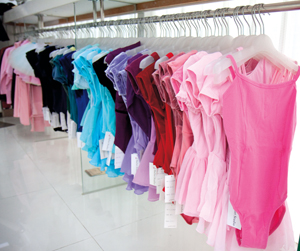 Ballet is the foundation of all dances," says founder and director of J-Ballet Studio, Japanese Junko Takeda. It is also a must for anyone studying figure skating or gymnastics, she adds. Takeda beganstudying ballet a year after arriving in Beijing in 1997. She attended weekend classes at Beijing Dance Academy, where her 18-year-olddaughter now studies ballet. While Takeda is not a professional dancer, she founded J-BalletStudio in 2004 after seeing the lack of balletclasses for young children. Following the popular Russian Vaganova style of ballet, J-Ballet Studio is where children can learn the beauty and grace of ballet in a fun, welcoming environment.
Ballet is the foundation of all dances," says founder and director of J-Ballet Studio, Japanese Junko Takeda. It is also a must for anyone studying figure skating or gymnastics, she adds. Takeda beganstudying ballet a year after arriving in Beijing in 1997. She attended weekend classes at Beijing Dance Academy, where her 18-year-olddaughter now studies ballet. While Takeda is not a professional dancer, she founded J-BalletStudio in 2004 after seeing the lack of balletclasses for young children. Following the popular Russian Vaganova style of ballet, J-Ballet Studio is where children can learn the beauty and grace of ballet in a fun, welcoming environment.
Starting Young
The student body is eclectic, with dancers hailing from all corners of the globe. One class has a mix of students from France, Japan and Australia. Though starting ages vary, J-Ballet accepts students no younger than 4 years old.
The studio provides an exciting, non-competitive environment, as students are encouraged to pursue ballet as more of a hobby than a profession. Yet, with regard to instruction, Australian mother of 7-year-old Paris Issa (who is starting her second year at J-Ballet) says, "They are strict, knowledgeable and professional." If a dancer progresses, the studio may provide more advanced instructionto meet their requirements. However, the goal of J-Ballet Studio is for everyone to enjoy ballet, not to become a professional ballet dancer.
 Ballet Basics
Ballet Basics
The mandatory dress code is simple: a balletleotard, pink tights and pink ballet shoes -which may be purchased at the nearby J-Ballet Studio Store (see opposite page for details). Girls with long hair are asked to wear it up and students who advance past Primary Ballet class are asked to forgo their tutus.
At the Main School, there are always two teachers present for children’s classes. A professional ballet teacher demonstrates and leads the class, while the assistant works on a more individual level, spotting and correctingany dancer who needs help with their stance or movement. Classes are taught primarily in Chinese by one of the school’s seven professional ballet teachers, with English used sparingly. Takeda, who assists all of the children’s classes as well as the adult beginner courses at the Main School, gives additional instruction in English or Japanese to students who cannot understand Chinese. Simple Chinese vocabulary is used, so any student with a basic level of Mandarin can follow the class.
"Turn out, straight and point" are Takeda’s three key points of ballet, which in detail refers to keeping your feet turned out, maintaining a straight back and legs, and pointing your toes. Children should also keep their chin up and carry strong arms as per the Russian-style preferred at the school.
 Facts and Figures
Facts and Figures
Classes at the Main School have no more than 14 students, with the average class ranging from two to seven students. At the Kempinski School branch, classes have only one teacher and the class contains no more than eight students due to the intimate size of the studio. If the current time slots are not suitable, the school may accommodate a new class for a group of three to four students. The school also offers a hip-hop class for kids. Its current members range from 6 to 12 years old.
Ballet classes at the studio range from beginner to advanced, with students placed in the appropriate class for their level and age. Classes are divided into eight levels: Primary, Pre-Grade 1, then Grade 1 through 5, and beyond. A basic course for children meets once a week and continues throughout the year. The summer course is generally five months long, while autumn and winter courses last around three to four months.
At the Main School, tuition for children’s classes start at RMB 60 per 60-minute Primary Ballet class and go up to RMB 80 per 90-minute Grade 5 Ballet class. Siblings receive a ten percent discount, as do students who attend two to three courses per week. Adult Ballet classes at the Main School cost RMB 80 per 90-minute class (RMB 10 less for student ID holders); discounts are available for adults who purchase 10 or 20 classes at a time. Classes at the Kempinski School branch start at RMB 910 for the 13-week Primary-Grade 1 Ballet class.
Showtime
Every two years, a ballet performance is put on by students of all ages from children to adults. An extra fee is required for dancers who want to participate; price varies each performance. Earlier this year, 150 J-Ballet students, representing over 13 countries performed at the Poly Theatre. Performances are not open to the public, but tickets are on sale to family members and friends of the students. Unfortunately, the school’s next big production isn’t scheduled until 2012.
 J-Ballet Studio Store
J-Ballet Studio Store
J-Ballet Store has everything a ballerina could dream of, from fluffy pastel-colored tutus to sparkly hair clips and soft teddy bears donning pink ballerina outfits. More importantly, students can purchase all the necessities for a beginner’s ballet class. Basic leotards for children start at RMB 50, tights are RMB 25 and ballet shoes range in price from RMB 25 for a basic pair to RMB 80 for the best quality.
Despite being a female-dominated form of dance, males are more than welcome to attend ballet classes. At the moment, Takeda is teachinga 10-year-old Japanese boy, who she says is an excellent student. "So serious and so handsome," she adds, with a laugh. Although he is currently the only male student at J-Ballet, children of all ages are welcome to "turn out, straight and point" at J-Ballet Studio – even boys.
 J-Ballet Studio J-芭蕾教室
J-Ballet Studio J-芭蕾教室
Contact Ms. Takeda at 8453 3003 or 138 0103 6364.
www.j-ballet.com
1) Main School: D-1/F Jingxiuyuan Apartments, Xingfucun Lu, Chaoyang District; 2) Kempinski School: Pulse Health Club, Kempinski Hotel, Lufthansa Centre, 50 Liangmaqiao Lu, Chaoyang District. 1) 朝阳区幸福村中路景绣园D座一层西侧; 2) 朝阳区亮马桥路50号, 凯宾斯基饭店, 北京燕莎中心, 都市脉搏健身俱乐部
J-Ballet Studio Store
Daily 10am-7pm. 38-12 Fortune Square Building, 38 Xingfuercun, Chaoyang District (8444 4700) 朝阳区幸福村二村38号楼, 首开幸福广场1层38-12底商



